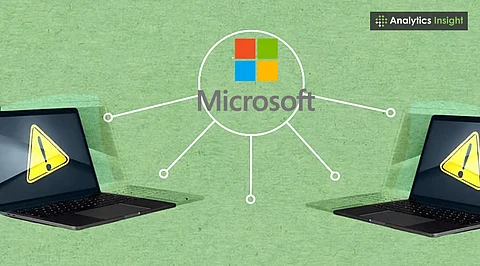

Microsoft faced yet another significant data breach in July 2025. The company confirmed that hackers had exploited a critical zero-day vulnerability in its on-premises SharePoint Server. Alarmingly, the targeted server was linked to approximately 100 organizations worldwide, underscoring persistent security gaps in Microsoft's on-premises software.
As cyberattacks against Microsoft systems grow increasingly sophisticated, concerns surrounding the company’s cybersecurity infrastructure continue to escalate, raising serious questions about the effectiveness of its current security protocols.
On Saturday, July 19, Microsoft alerted users to ‘active attacks’ on self-hosted SharePoint servers. Two days later, on Monday, reports surfaced highlighting the victims. These servers are mostly used by organizations for sharing documents and collaboration. Microsoft authorities officially marked it as a ‘zero-day’ attack because the attackers exploited previously unknown digital vulnerabilities.
This breach has impacted a range of organizations across different countries. Notably, several government agencies in the U.S. and Germany, as well as financial institutions and healthcare providers, have fallen victim to this cyber hack. As of the time of writing, no solid evidence has been reported regarding the initiator of this hack; however, the mastermind behind these events is believed to be a China-linked group.
The FBI has acknowledged this cyberattack, and Britain's National Cyber Security Center mentioned that they are aware of a “limited number” of victims from the United Kingdom. Even Microsoft has acknowledged this cyberattack, but the company spokesperson closed the conversation by mentioning they have “provided security updates and encourage customers to install them.”
Statements from ethical hackers also highlight Microsoft’s security vulnerabilities. Vaisha Bernard, Chief Hacker at Eye Security, remarked on the incident’s severity, mentioning, “It’s unambiguous… Who knows what other adversaries have done since to place other backdoors.”
Also Read: Microsoft Takes Down 3,000 North Korea-Linked Accounts in Global IT Scam
This is not the first time Microsoft has faced this situation. In the last five years, almost every year, this company has faced something severe related to cybersecurity. Below is the list of previous data breaches that Microsoft has faced over the last five years:
Year 2019: In December 2019, this tech giant faced a data breach where customer records were exposed due to a misconfigured database. This Customer Records Exposure leaked over 250 million customer records. Microsoft reacted immediately after this cybersecurity issue came to light and fixed the database, stating that there were no reports of using the leaked data maliciously.
Year 2020: The next year, Microsoft faced the LinkedIn data scraping hack, where hackers extracted information from LinkedIn profiles. In response, Microsoft, the owner of LinkedIn, made the data usage and privacy stricter to avoid future issues.
Year 2021: Next comes the Microsoft Exchange Server Breach. It was a large-scale cyberattack that exploited the vulnerabilities of the on-premises Microsoft Exchange Servers, enabling attackers to gain unauthorized access and steal emails, passwords, and other sensitive information. Microsoft released security patches to fix it.
Year 2022: In this Microsoft data breach, a misconfigured Microsoft Azure Blob Storage leaked sensitive customer data of over 65,000 people across 111 countries. The key reason was that the storage data was accessible to unauthorized users. However, Microsoft, in an official statement, denied the number of victims, stating that it’s an exaggeration of the actual number.
This tradition continues in 2023 and 2024. Microsoft falls victim to Chinese hackers breaching the U.S. State Department and Russian hackers breaching the company, resulting in Microsoft cyberattacks, respectively. Every time, this tech giant falls victim to these data breaches, highlighting its cybersecurity vulnerabilities.
Microsoft has been fighting with data breaches over these years. The recent Microsoft cyberattack, specifically the SharePoint breach, once again highlights the concerning security landscape within Microsoft. Despite its dominating presence in cloud services, Microsoft’s on-premises products require a significant modification to link in enterprise cybersecurity.
The over-reliance on customer-managed deployments often leads to outdated systems, delayed patching, and complex configurations. These are the primary factors to create ground for exploitation by hackers. Moreover, every time, this company shows a similar tendency to issue patches after the breach to fix that exploited vulnerability, without fully mitigating the broader risk. Therefore, the possibility of future risks remains the same.
Microsoft cyberattack 2025 shows how the company can easily fall victim to these attackers by leaving the backdoors open but undetected. Across the globe, thousands of companies use Microsoft services. While big corporations can take measures immediately, small ones need time to react, which increases their risks. They often struggle with timely patching and comprehensive security measures, leaving them more vulnerable.
To conclude, the Microsoft Hack 2025 incident pointed out the need for a more careful examination of the designs, security, and support of enterprise software. Transforming this scenario is difficult until the company adopts an approach that prioritizes proactive threat detection, continuous monitoring, and comprehensive remediation strategies.
Also Read: Best Microsoft Power BI Courses & Certificates Online in 2025
